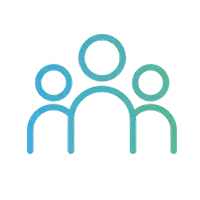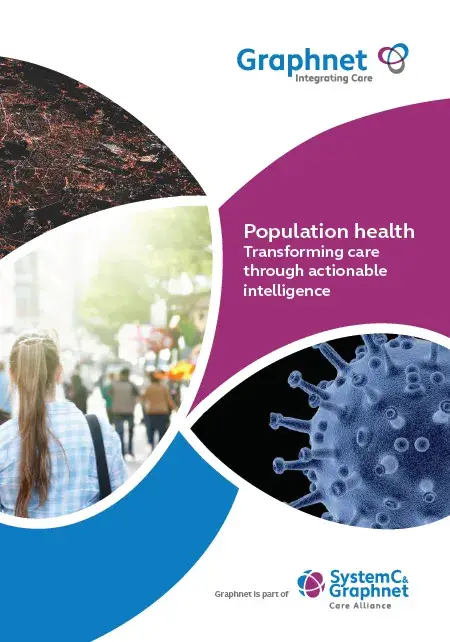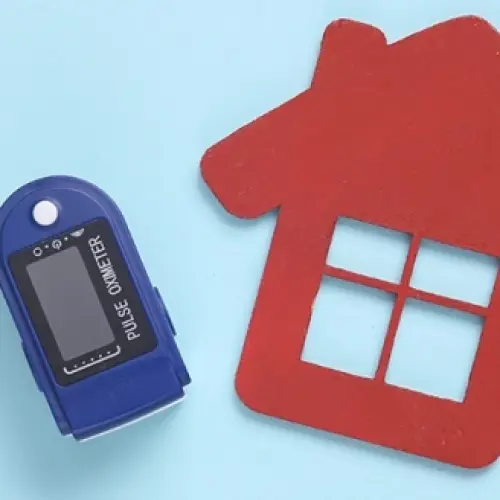
Population health
Over 15.5m citizens benefit from targeted care using Graphnet's population health management tools. Working collaboratively with ICS partners, the system is leading the way in data-rich population health intelligence that provides actionable insights for the reset, recovery, resilience and continuous improvement of health and care economies.
The population health platform uses integrated health and social care data held in CareCentric shared care record to produce richer insights at population, place, cohort and individual level. Insights that are driving actions such as identifying and enrolling individuals onto acute and chronic disease remote monitoring programmes. Enabling clinicians to drill through to the integrated personal health record. Analytical tools are used to evaluate and measure the impact of interventions on patient engagement, compliance to treatment targets, behaviour and disease control. Insight can be presented back into an integrated record, closing the loop and enabling clinicians to use insight to take action through a 360-degree seamless, integrated solution.
How it works:
The data intelligence generated by the population health platform is used to drive actions. This includes planning services such as working out what is needed, predicting when and where a surge in demand will likely come from and putting appropriate measures in place. The platform enables evaluation and provides learning to support continuous improvement and best practices through the ability to study the impact of interventions. It empowers Integrated Care Systems to develop their own analytical eco-systems by providing a configurable platform which enables homegrown analytics, importing local data sets and the opportunity to share and collaborate with colleagues in other areas. Using shared care and personal health record data intelligently, integrated care systems will operate more agilely, adapting and scaling up new services as demands change.
Key benefits:
- Elective recovery analytics enable Acute waiting lists to be analysed alongside wider population health data to allow easy to action, Consultant level lists of patients to aid validation such as deceased patients, duplicate entries or patients who may have been treated elsewhere. By analysing blood tests or BMI scores, consultant lists can also be stratified to identify patients at risk due to their co-morbidities or deterioration. Health equity analysis is also covered through the provision of analysis by demographic influencers, identifying trends in access to vulnerable patient groups and identifying those groups at risk of health inequalities.
- Command centre dashboards provide an executive lens on local service demand, capacity, and resources to support system-level decision-making. Using a mixture of real-time and regular Sitrep reporting information, Integrated Care System can now understand pressures in their system, such as emergency attendances, the acuity of admitted patients, bed capacity, discharges and the capacity available in social, mental health and community care across their entire footprint. This enables proactive day-to-day management and planning of system capacity and demand.
- Health Equity analysis is a key component of any population health toolkit, and tools to support the NHS 20+5 approach are embedded within the platform. Identification of the Core 20 population is made easier as each population health patient record is linked to an index of mass deprivation score. Fuel poverty and key national data sets such as Fingertips are available for wider analysis. Pregnancy vaccination uptake and equity dashboards enable analysis of health inequalities in vaccinations for pregnant women through age, ethnicity, and deprivation analysis. Serious mental illness health check dashboards identify vulnerable patients who may have missed a health check, enabling action. Enhanced case-finding tools identify hypertensive patients and candidates for remote blood pressure monitoring. Vaccination uptake of Chronic respiratory disease is monitored through NIMS Covid and Flu uptake dashboards, and Cancer data analysis can better support the NHS’s aim of earlier diagnosis by enabling a better understanding of care and treatment pathways for patient groups at risk of health inequalities.
- Enhanced case-finding enables an Integrated Care System to case find at scale (from ICB to practice level) by using the rich population health data to rapidly identify individuals and specific groups who could benefit from early intervention for integrated and proactive care. The tool brings together key data points from across health and care, links in health equity markers, and uses the world leading risk stratification algorithms from the Johns Hopkins ACG® System to enable effective population stratification based on several different models, including the risk of emergency admissions and risk of mortality. Rich diagnostic profiling is also enabled, identifying long-term conditions, prescriptions, and patients at risk of polypharmacy or who have frequent admissions to A&E.
Case studies:
Combined Intelligence for Population Health Action (CIPHA) study.
Findings from 11 Nov 2020 to 27 Feb 2021 (108 day period):
- 42% reduction in mortality in shielded, hospitalised patients
- 50% reduction in mortality in hospitalised patients who are not shielded
- 28 lives saved
- Median lengths of hospital stay reduced from 9 days to 7 day
*Population health management tool is powered by Graphnet, part of the System C & Graphnet Care Alliance.
Key components
Rich, integrated health and social care dataset
Available to draw upon by embedding analytics into CareCentric shared record.
Cohort mapping engine
Delivers standardised diseases and wellness registries (e.g. QOF and eFI).
Data science platform
Enables the use of off-the-shelf models and collaboration with academia and third-party solutions.
Decision support to detect, alert and optimise
Highlights areas for service optimisation, improving services, and reducing health inequalities.
Visualisations
For easier and more intuitive monitoring and evaluation, we provide tailored dashboards.
Business Intelligence
Highly configurable platform enables access to CareCentric shared record data for decision support.
Interoperable
Our easy to use and industry-standard APIs are available for authorised third-party access.
Risk stratification
We use advanced machine learning, statistical and mathematical models to actively forecast and monitor patients.
Collaborative
Enabling collaboration between care providers, commissioners, policy makers and academia.

















